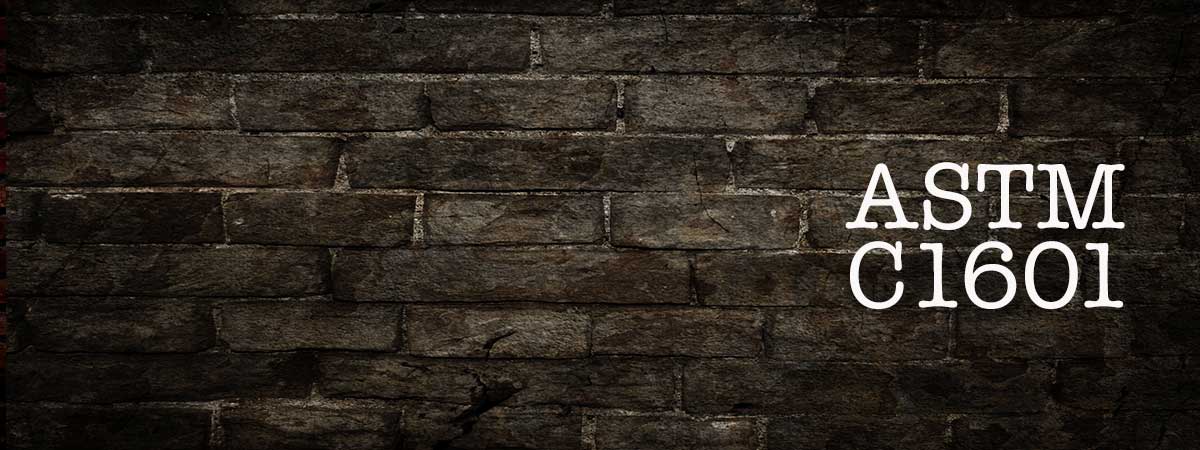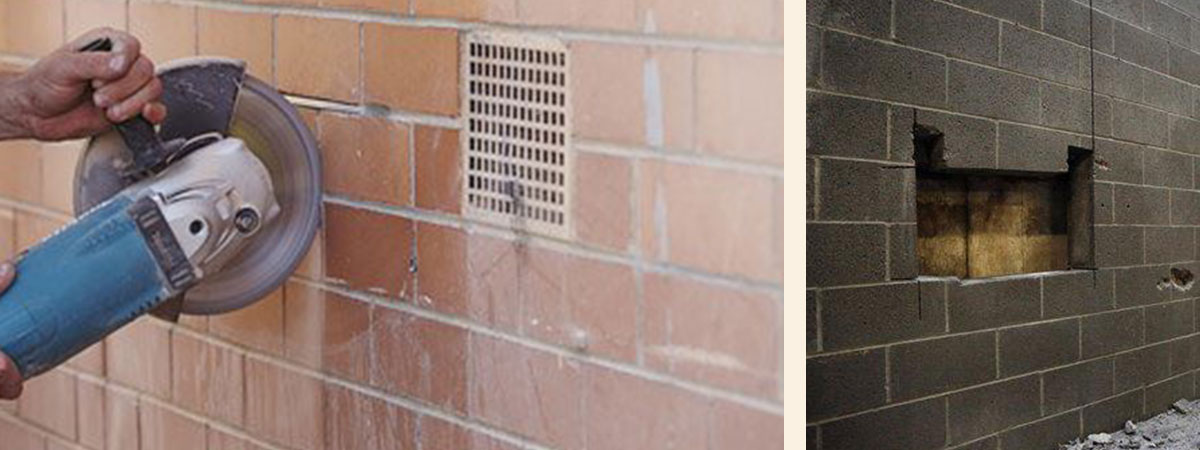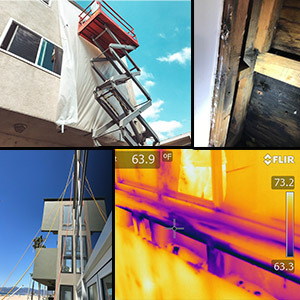
ASTM C1601-1 Standard Test Method for Field Determination of Water Penetration of Masonry Wall Surfaces
Applicable to masonry wall systems, the ASTM C1601-1 Standard Test Method for Field Determination of Water Penetration of Masonry Wall Surfaces is a standard that chronicles the procedure by which a test is performed. The standardized test will determine the amount of water a masonry wall’s surface will absorb within a specific area, over a specific amount of time, with a specified water flow rate, under specific atmospheric air pressure conditions. Todays ASTM C1601 Water Penetration standard was conceived from the ASTM laboratory version, ASTM 514 which is a standard used in testing building materials, waterproof coatings
The ASTM C1601 Water Penetration standard was derived from the laboratory version, the ASTM E514 – Standard Test Method For Water Penetration And Leakage Through Masonry. The ASTM E514 provides information that aids in evaluating the effect of four principal variables: materials, coatings, wall design, and workmanship.
Water Penetration of Masonry Walls – ASTM C1601
In order to properly facilitate a ASTM C1601 Water Penetration standardized test, an 3′ x 4′ air chamber is constructed from aluminum with a .25″ plexiglass-glass cover attached to the front of the chamber and mounted to the wall. Prior to mounting the apparatus to the wall, the chamber is sealed to the wall utilizing various different types of sealants to keep the chamber relatively water tight. The test is to simulate a 62 MPH wind force and over 5″ of rainfall for every hour of test.
Reasons To Test Masonry Walls For Moisture Penetration
There are many reasons for this test to be performed by general they fall under just a handful of categories.
- Test existing wall systems
- New construction quality assurance
- Litigation cases
- Repairs
- Test walls which are believed to leak
- Test waterproof coatings
Los Angeles Water Penetration of Masonry Walls
Test chambers are used in conjunction with water flow meters, centrifugal blowers and metering devices to maintain internal air pressure differentials across the test area. For water, there are spray nozzles spaced 1″ apart from one another which spray a sheet-like flow onto the masonry wall at a rate of 3.4 gal/ft²/hr within the chamber. During the beginning of the test, there is a 30 minute pre-conditioning period allows.
This way, the operator can calibrate his equipment to the ASTM C1601 standards. Once the test is underway, water is continually sprayed for four (4) hours onto the specimen. Outside of the chamber, water is pumped from a holding tank or reservoir at a rate of 3.4 gal/ft²/hr at the same time the centrifugal blowers and metering devices are working to maintain the pressure at 10lbs/ft².
ASTM E2128, Standard Guide for Evaluating Water Leakage of Building Walls
Contrary to the ASTM C1601, the ASTM 2128 standard guide for evaluating water leakage of building walls speaks to the methods for evaluating water intrusion of a buildings exterior walls. ASTM 2128 provides a series of events or steps one must perform in order to carry out a building wall leak assessment program.
Discovery

- Review documents of the project including design drawings, concepts and service history
- Job Walk -this is a visual inspection of the buildings conditions including testing and working with the owner or contractor to provide exploratory openings in key locations
- Analysis and reporting
Visual Inspection
When instituting a visual inspection program, some of the biggest objectives are;
- Water damage or moisture intrusion documentation
- Observations of actual leaks or paths of travel
- Propose an explanation of potential causes for water intrusion into building walls
When performing a visual inspection of the building we want to take into consideration both interior as well as exterior wall systems alike. Furthermore, it’s at this time where window, door, skylight openings are through inspected. Other projections into the building are also taken into consideration and documented as necessary.
Forensic Investigative Testing Of Water intrusion Into Building Walls
Los Angeles is known for its beautiful older masonry structures. These older structures often leak water due to a multitude of potential issues associated with these older building facades. In order for us to determine water penetration entry points, we must perform forensic analysis of the buildings exterior wall system. This is to say, we will want to recreate leaks which are known for a fact to occur.
Not only will this type of forensic testing produce leaks which are traceable and therefore able to be observed and corrected, but these tests are also repeatable. Which is to say, at any time, these tests can be duplicated to produce the same results.
Moreover, testing of wall systems should only be performed in its current, unmolested condition, free of service or repairs. Furthermore, starting from the bottom and working upwards, testing of the wall may include isolating areas of the wall which may be directly affected by forensic testing of a specific locations as not to create false positives etc… Adjacent components such as fenestration products should still, however, be tested individually at some point.
Should testing in this manner produce leaks, leaks should therefore be traced to its origin.
ASTM C1601 Water Penetration | Destructive Testing
Removal of interior wall coverings within the area of testing are necessary to observe water penetration. We feel it prudent to note that in older buildings toxic materials such as asbestos laced drywall or plaster may have been used and should therefore be tested prior to removal.
On the other hand, if the material is a non toxic material such as a more modern gypsum board or plaster its a good idea to remove only whats considered necessary to observe leaking patterns without disturbing the original state of the wall in order to replicate leaks as they would naturally occur.
Calibrated Spray Rack System On Masonry Wall Systems
Even though the spray rack is an essential part of the AMMA and ASTM fenestration testing standards, it too can be used in exploratory water testing of masonry exterior wall systems. At the same time, however, the use of an internal negative air chamber to create a differential across the masonry wall thickness is somewhat uncommon.
Calibrated spray rack apparatus are extremely effective in placing water in a specific location for a specified amount of time. The spray rack is capable of a 8×8 spray area and can easily be moved up the side of a building.
Exploratory Openings

Exploratory openings are otherwise known better as destructive testing is a fundamental step in locating. leaks within masonry exterior wall systems. Even with the use of thermography to locate leaks in masonry walls, still, it’s difficult to isolate the leaks origin.
Generally speaking, when we conduct moisture analysis on masonry wall systems, we are accompanied by a representative of the owner, contractor or other tradesman who can assist in the cutting of the wall and making these exploratory openings.


